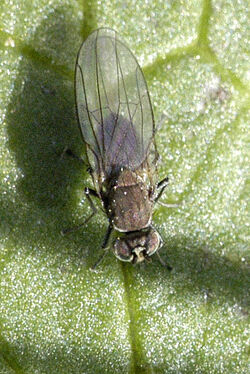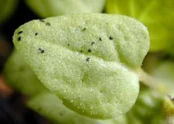| Shore fly | |
|---|---|
 |
|
| Hydrellia griseola | |
| Scientific Classification | |
| Kingdom: | Animalia |
| Phylum: | Arthropoda |
| Class: | Insecta |
| Order: | Diptera |
| Suborder: | Brachycera |
| Superfamily: | Ephydroidea |
| Family: | Ephydridae |
| Synonyms | |
| Brine fly Shore fly |
|
Shore flies are tiny flies that can be found near seashores or at smaller inland waters, such as ponds. Shore flies do not damage most plants by feeding on them, as they feed largely on algae. However, the flies may leave faecal spots on foliage and may spread plant diseases such as Pythium and Thielaviopsis. They are commonly found in wet conditions which encourage algal growth.[1]
Pest characteristics[]
Adult flies[]
The adult is a small, robust black fly, about 4mm (⅛in) long, often seen sitting on plants, compost, bench or floor coverings. The antennae are short and stubby and each wing has five pale spots, giving a ‘domino' effect.[1]
Eggs[]
The eggs are small (about 0.4 mm long) and white, with a net-like pattern on the surface.[1]
Larvae[]
The three larval stages are transparent, allowing the brown gut contents to be seen through the body wall, thus the larvae are difficult to see on the surface of the compost or substrate.[1]
Symptoms[]
Faecal spotting may be seen on the leaves.
Prevention[]
Organic[]
Cultural[]
- Shore flies feed and breed on algae, so minimising algal growth is key to reducing fly populations. Avoid over-watering and keep benches, gutters, floor coverings and irrigation equipment as clean as possible.[1]
- Horticultural fleece may be used over the plants in the early stages of production, to reduce shore fly egg-laying on the growing substrate. However, the fleece must be removed as the plants grow.[1]
- Yellow sticky traps will catch adult flies. These can be placed on or above benches or floors. Long ‘curtain' sticky traps should be used with care, as they will also catch large numbers of flying beneficial insects e.g. parasitic wasps.[1]
Biological control[]
The following species can be used to control an infection of leafhoppers:
- Atheta coriara
A ground-dwelling predatory ‘rove' beetle. Atheta coriaria is commercially available for the control of both sciarid and shore flies[1]
- Parasitoids
Two shore fly parasitoids, Aphaereta debilitata and Kleidotoma psiloides occur naturally.[1]
Examples[]
Reference[]
| This page uses Creative Commons Licensed content from Wikipedia (view authors). |
| Mint troubles |
|
|---|---|
| Basil · Lavender · Lemon balm · Marjoram · Mint · Oregano · Rosemary · Sage · Savory · Thyme | |
| Adverse conditions | Bolting |
| Diseases | Downy mildew · Fusarium wilt · Grey mould · Powdery mildew · Rhizoctonia solani · Rust · Septoria leaf spot of lemon balm · Verticillium wilt |
| Pests | Aphid · Cabbage whitefly · Capsid bug · Celery fly · Leaf miner · Leafhopper · Red spider mite · Shore fly · Silver Y moth · Slug |
